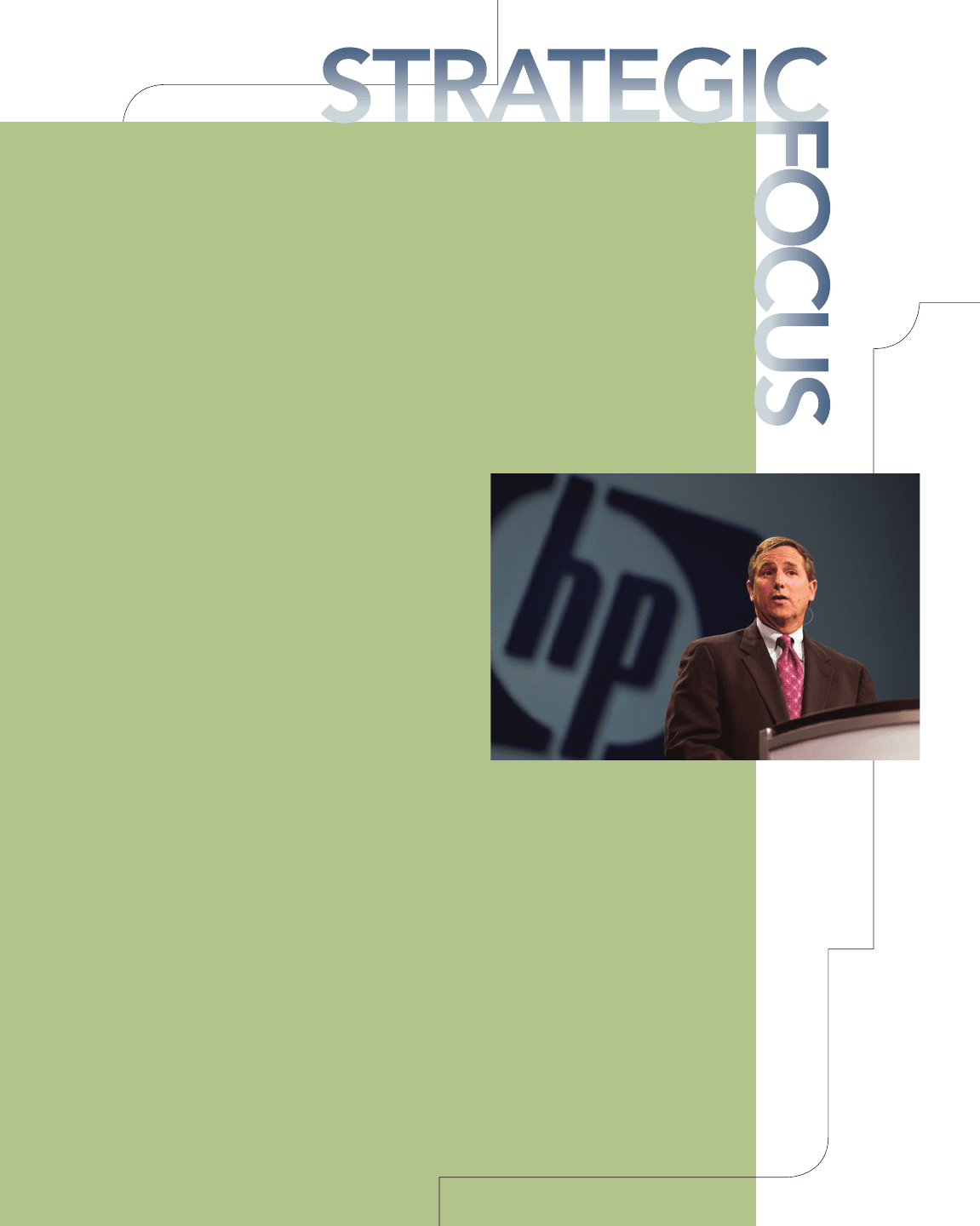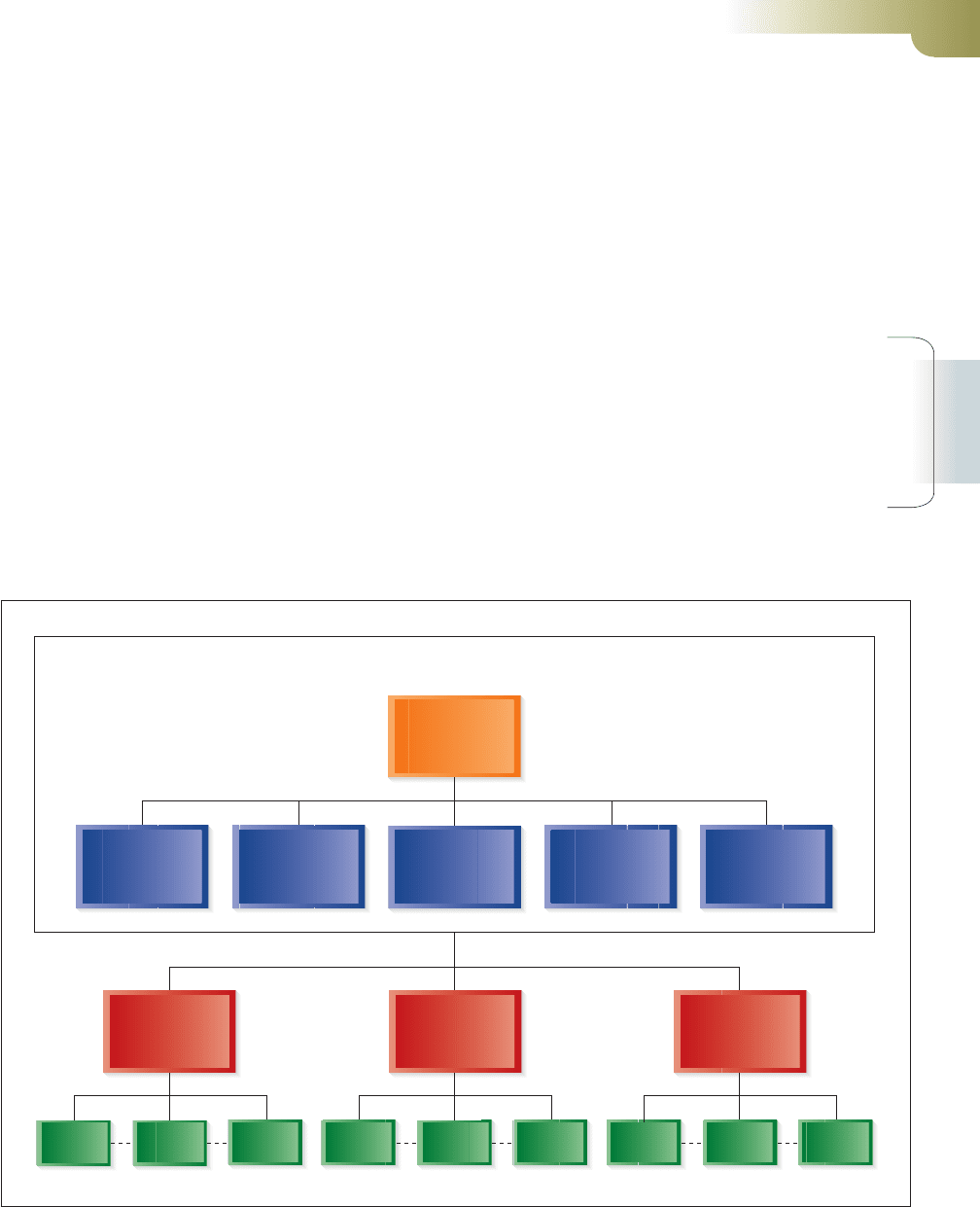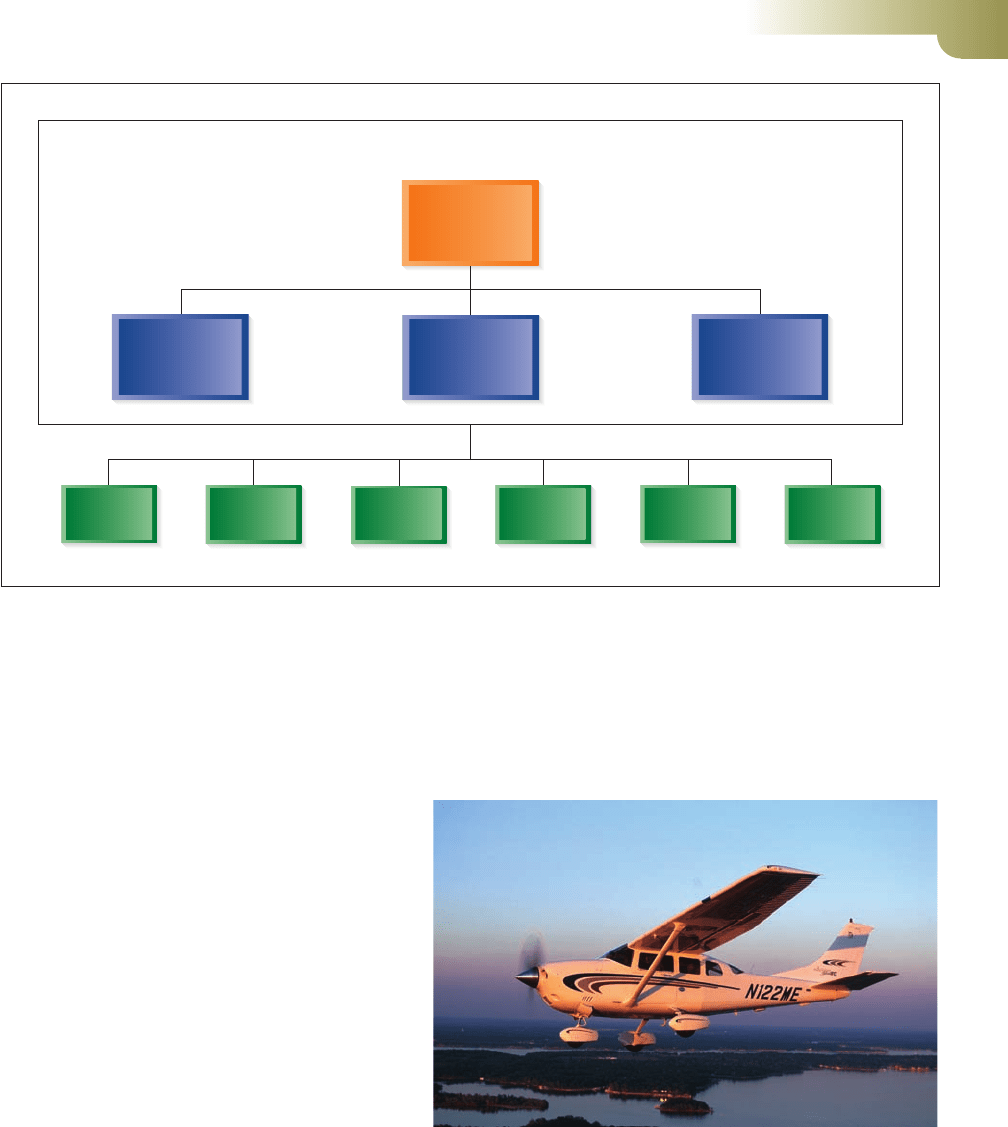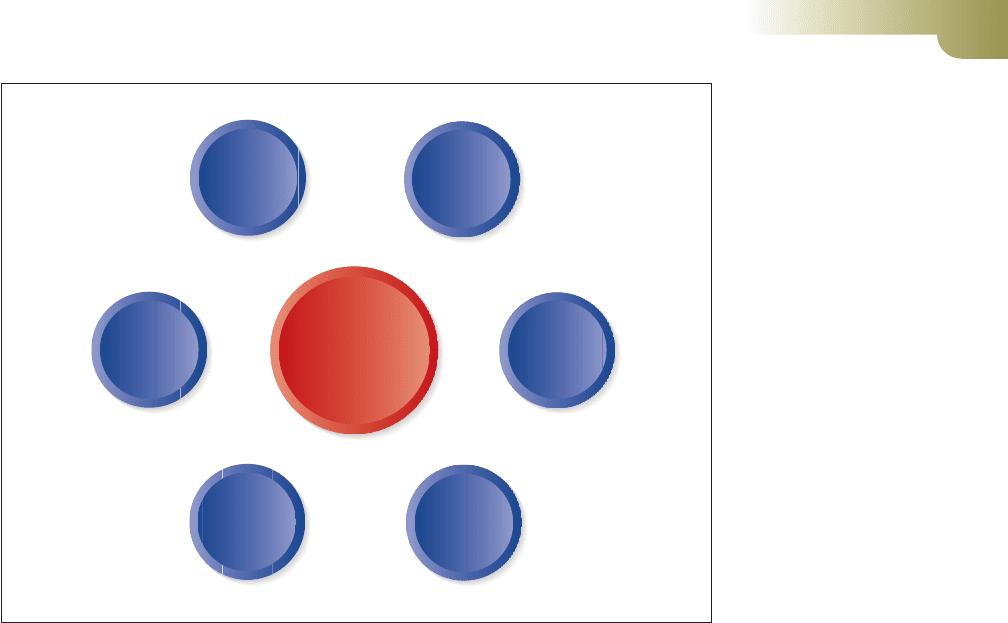Hitt M.A., Ireland R.D., Hoskisson R.E. Strategic Management: Competitiveness and Globalization: Concepts
Подождите немного. Документ загружается.


328
Part 3: Strategic Actions: Strategy Implementation
Multidivisional
Structure
(M-form)
Strategic Business Unit
(SBU) Form
Cooperative
Form
Competitive
Form
Figure 11.4 Three Variations of the Multidivisional Structure
Government
Affairs
Legal
Affairs
President
Headquarters Office
Corporate
Human
Resources
Corporate
Marketing
Corporate
Finance
Strategic
Planning
Corporate
R&D Lab
Product
Division
Product
Division
Product
Division
Product
Division
Product
Division
Figure 11.5 Cooperative Form of the Multidivisional Structure for Implementing a Related Constrained Strategy
Notes:
• Structural integration devices create tight links among all divisions
• Corporate office emphasizes centralized strategic planning, human resources, and marketing to foster cooperation between divisions
• R&D is likely to be centralized
• Rewards are subjective and tend to emphasize overall corporate performance in addition to divisional performance
• Culture emphasizes cooperative sharing

Hewlett-Packard (HP) has three main related
businesses through which it pursues industry
leadership and technology development.
First, it has the Personal Systems Group,
including business and consumer PCs,
mobile computing, and workstation devices.
Second, it has a complementary business with a very large market share in Imaging and
Printing, which includes inkjet and laserjet printers, commercial printing, printing supplies,
digital photography, and entertainment products and support. Finally, it has a Technology
Service Solutions Group, which includes business products focused on servers and storage,
managed services and software, and services solutions. This group has been augmented
through its recent acquisition of Electronic Data Systems (EDS). HP is number nine in the
2009 Fortune 500 Ranking with more than $118 billion in total revenue for fiscal year 2008.
Its main focus for customers is on corporate data centers that allow connected mobile
computing, printing, and imaging delivery. HP pursues a related constrained strategy (as
discussed in Chapter 6) by using the cooperative
M-form structure. As firms pursue diversified
growth and the economy becomes more Internet
based, corporate data centers are increasingly
important to help firms pursue improved top-line
and bottom-line growth. HP’s three main businesses
allow the related strategy to work well by focusing
on the growing importance of corporate data
centers. Firms that seek to deliver the products
and services necessary to the centers are required
to have interrelated services and businesses to sell
integrated solutions.
This is driving firms that have a dominant focus
on one product category to move into the other
categories. For instance, Cisco, as noted in the
Opening Case, is moving toward a corporate data
center approach but coming at it from a traditional
focus on network equipment. For this reason it is
now moving into servers, which has been one of HP’s
dominant businesses (Cisco previously partnered
with HP in this area). Like Cisco, HP has moved away
from its formerly decentralized structure toward a related constrained strategy by seeking to
implement the cooperative M-form organization structure. The cooperative M-form requires
more centralization to make it function appropriately and to foster cooperation between
the separate divisions within and across business unit divisions. This requires distinctive
leadership and focus on improved execution to function properly.
Mark Hurd, the current CEO who succeeded Carly Fiorina in 2005, has been able to fine-
tune HP’s structural approach through his “get things done” mentality. One security analyst
describes Hurd as someone who is, “… all about execution and has an uncanny ability to get
things done.” Furthermore, this same analyst suggests, “He is the most adept at taking costs
out of the system than any executive I know.” His no-nonsense style has led to increasing
operational efficiency by realizing a strong implementation of the cooperative M-form
structure. For instance, through the $13 billion acquisition of the consulting services firm
HEWLETT-PACKARD
IMPLEMENTS THE RELATED
CONSTRAINED STRATEGY
THROUGH THE COOPERATIVE
M-FORM STRUCTURE
Mark Hurd, President and CEO of
Hewlett-Packard, has increased
efficiency and reduced costs at HP
through the implementation of the
cooperative M-form structure.
David Paul Morris/Getty Images News/Getty Images

330
Part 3: Strategic Actions: Strategy Implementation
among its products (servers, storage, mobile computing, and high-speed printers) and
coordinating these products through value-added services. This has required the
implementation of the cooperative M-form and more centralization among the vari-
ous business units to foster cooperation and synergy.
Sharing divisional competencies facilitates the corporation’s efforts to develop econ-
omies of scope. As explained in Chapter 6, economies of scope (cost savings resulting
from the sharing of competencies developed in one division with another division) are
linked with successful use of the related constrained strategy. Interdivisional sharing of
competencies depends on cooperation, suggesting the use of the cooperative form of the
multidivisional structure.
82
HP seems to have developed the structure and processes well
to accomplish this.
The cooperative structure uses different characteristics of structure (centralization,
standardization, and formalization) as integrating mechanisms to facilitate interdivisional
cooperation. Frequent, direct contact between division managers, another integrating
mechanism, encourages and supports cooperation and the sharing of competencies
or resources that could be used to create new advantages. Sometimes, liaison roles are
established in each division to reduce the time division managers spend integrating and
coordinating their unit’s work with the work occurring in other divisions. Temporary
teams or task forces may be formed around projects whose success depends on sharing
competencies that are embedded within several divisions. Cisco has used these devices to
develop new cooperative strategies, as illustrated in the Opening Case. Formal integration
departments might be established in firms frequently using temporary teams or task
forces.
Ultimately, a matrix organization may evolve in firms implementing the related con-
strained strategy. A matrix organization is an organizational structure in which there
is a dual structure combining both functional specialization and business product or
project specialization.
83
Although complicated, an effective matrix structure can lead to
improved coordination among a firm’s divisions.
84
The success of the cooperative multidivisional structure is significantly affected by
how well divisions process information. However, because cooperation among divi-
sions implies a loss of managerial autonomy, division managers may not readily commit
EDS in 2008, Hurd cut 15,000 jobs or 10 percent of the workforce to create the synergistic
effect needed across all businesses. In 2009, this led HP to project a decline of 5 percent
in revenues, but to still be able to project a 6 percent growth in profits, all despite the
economic downturn.
Although the cooperative structure implementation has created wealth and efficiency,
there are those who speculate that Hurd’s approach has an Achilles heel because it lacks an
emphasis on breakthrough innovation such as Apple’s iPod and iPhone. Robert Burgelman,
a Stanford professor who has studied Hurd, says, “He will not tell them we should do this
project or that project. He helps them think more clearly about the space in which they are
operating.” While these actions have made HP’s R&D operations more efficient, Hurd may
need to give employees more creative license if he wants breakthrough innovations that
would allow HP to compete more effectively with IBM and Apple.
Sources: J. Brodkin, 2009, HP BladeSystem, Matrix takes aim at Cisco, Network World, April 20, 34; A. Lashinsky, 2009,
Mark Hurd’s moment, Fortune, March 16, 90–100; J. Scheck, 2009, Corporate news: HP chief sees more pain ahead,
trims more jobs, Wall Street Journal, May 20, B3; B. Worthen & J. Scheck, 2009, H-P to step up fight in market for
servers, Wall Street Journal, April 16, B5; C. Edwards, 2008, How HP got the wow! back, BusinessWeek, December 20,
60; J. Fortt, 2008, Mark Hurd, superstar, Fortune, June 29, 35; J. Jain, 2008, Decision sciences: A story of excellence
at Hewlett-Packard, OR-MS Today, 35(2): 20; L. Lee, 2008, HP’s Hurd is about to be tested: After a sterling three-year
run, the company’s CEO faces a weaker PC market and a stronger Dell, BusinessWeek, February 14, 59–60; 2008,
Business: Now services; Hewlett-Packard, Economist, May, 78; D. M. Zell, A. M. Glassman, & S. A. Duron, 2007, Strategic
management in turbulent times: The short and glorious history of accelerated decision making at Hewlett-Packard,
Organizational Dynamics, 36(1): 93–104.

331
themselves to the type of integrative information-processing activities that this structure
demands. Moreover, coordination among divisions sometimes results in an unequal flow
of positive outcomes to divisional managers. In other words, when managerial rewards
are based at least in part on the performance of individual divisions, the manager of the
division that is able to benefit the most by the sharing of corporate competencies might
be viewed as receiving relative gains at others’ expense. Strategic controls are important in
these instances, as divisional managers’ performance can be evaluated at least partly on the
basis of how well they have facilitated interdivisional cooperative efforts. In addition, using
reward systems that emphasize overall company performance, besides outcomes achieved
by individual divisions, helps overcome problems associated with the cooperative form.
Using the Strategic Business Unit Form of the Multidivisional Structure to
Implement the Related Linked Strategy
Firms with fewer links or less constrained links among their divisions use the related
linked diversification strategy. The strategic business unit form of the multidivisional
structure supports implementation of this strategy. The strategic business unit (SBU)
form
is an M-form structure consisting of three levels: corporate headquarters, strategic
business units (SBUs), and SBU divisions (see Figure 11.6). The SBU structure is used
by large firms and can be complex, given associated organization size and product and
market diversity.
President
Headquarters Office
Strategic
Planning
Corporate
Marketing
Corporate
Human
Resources
Corporate
Finance
Corporate
R&D
Strategic
Business
Unit
Strategic
Business
Unit
Strategic
Business
Unit
Division Division
Division
Division DivisionDivision Division DivisionDivision
Figure 11.6 SBU Form of the Multidivisional Structure for Implementing a Related Linked Strategy
Notes:
• Structural integration among divisions within SBUs, but independence across SBUs
• Strategic planning may be the most prominent function in headquarters for managing the strategic planning approval process of SBUs for the president
• Each SBU may have its own budget for staff to foster integration
• Corporate headquarters staff members serve as consultants to SBUs and divisions, rather than having direct input to product strategy, as in the cooperative form
The strategic business
unit (SBU) form is an
M-form consisting of
three levels: corporate
headquarters, strategic
business units (SBUs),
and SBU divisions.
Chapter 11: Organizational Structure and Controls

332
Part 3: Strategic Actions: Strategy Implementation
The divisions within each SBU are related in terms of shared products or markets or
both, but the divisions of one SBU have little in common with the divisions of the other
SBUs. Divisions within each SBU share product or market competencies to develop
economies of scope and possibly economies of scale. The integrating mechanisms used
by the divisions in this structure can be equally well used by the divisions within the
individual strategic business units that are part of the SBU form of the multidivisional
structure. In this structure, each SBU is a profit center that is controlled and evaluated by
the headquarters office. Although both financial and strategic controls are important, on
a relative basis financial controls are vital to headquarters’ evaluation of each SBU; stra-
tegic controls are critical when the heads of SBUs evaluate their divisions’ performances.
Strategic controls are also critical to the headquarters’ efforts to determine whether the
company has formed an effective portfolio of businesses and whether those businesses
are being successfully managed.
Sears Holdings changed to the SBU form in 2008 by dividing into five strategic
business units (with multiple divisions as parts of each SBU): brands, real estate, support,
online, and store operations.
85
This allowed for related businesses to work together (such
as Sears and K-Mart) to focus on their distinct customer sets, but also provided for better
control for headquarters in order to evaluate performance of each strategic business unit
and division within the SBU.
Sharing competencies among units within an SBU is an important characteristic of
the SBU form of the multidivisional structure (see the notes to Figure 11.6). A drawback
to the SBU structure is that multifaceted businesses often have difficulties in commu-
nicating this complex business model to stockholders.
86
Furthermore, if coordination
between SBUs is needed, problems can arise because the SBU structure, similar to the
competitive form discussed next, does not readily foster cooperation across SBUs.
Using the Competitive Form of the Multidivisional Structure to Implement
the Unrelated Diversification Strategy
Firms using the unrelated diversification strategy want to create value through efficient
internal capital allocations or by restructuring, buying, and selling businesses.
87
The com-
petitive form of the multidivisional structure supports implementation of this strategy.
The competitive form is an M-form structure characterized by complete indepen-
dence among the firm’s divisions which compete for corporate resources (see Figure 11.7).
Unlike the divisions included in the cooperative structure, divisions that are part of the
competitive structure do not share common corporate strengths. Because strengths are
not shared, integrating devices are not developed for use by the divisions included in the
competitive structure.
The efficient internal capital market that is the foundation for using the unrelated
diversification strategy requires organizational arrangements emphasizing divisional
competition rather than cooperation.
88
Three benefits are expected from the
internal competition. First, internal competition creates flexibility (e.g., corporate
headquarters can have divisions working on different technologies and projects
to identify those with the greatest potential). Resources can then be allocated to
the division appearing to have the most potential to fuel the entire firm’s success.
Second, internal competition challenges the status quo and inertia, because division
heads know that future resource allocations are a product of excellent current
performance as well as superior positioning in terms of future performance. Last,
internal competition motivates effort in that the challenge of competing against
internal peers can be as great as the challenge of competing against external rivals.
89
In this structure, organizational controls (primarily financial controls) are used to
emphasize and support internal competition among separate divisions and as the
basis for allocating corporate capital based on divisions’ performances.
Textron Inc., a large “multi-industry” company seeks “to identify, research, select,
acquire and integrate companies, and has developed a set of rigorous criteria to guide
The competitive form is
an M-form structure
characterized by complete
independence among
the fi rm’s divisions which
compete for corporate
resources.

333
Chapter 11: Organizational Structure and Controls
decision making.” Textron continuously looks
“to enhance and reshape its portfolio by divesting
non-core assets and acquiring branded businesses
in attractive industries with substantial long-term
growth potential.” Textron operates four indepen-
dent businesses—Bell Helicopter (20 percent of
revenue), Cessna Aircraft (40 percent), Textron
Systems (15 percent), Finance (5 percent), and
Industrial (20 percent). The firm uses return on
invested capital (ROIC) as a way to evaluate the
contribution of its diversified set of businesses as
they compete internally for resources.
90
To emphasize competitiveness among divi-
sions, the headquarters office maintains an
arm’s-length relationship with them, intervening
in divisional affairs only to audit operations and discipline managers whose divisions
perform poorly. In emphasizing competition between divisions, the headquarters
office relies on strategic controls to set rate-of-return targets and financial controls
to monitor divisional performance relative to those targets. The headquarters office
then allocates cash flow on a competitive basis, rather than automatically returning
cash to the division that produced it. Thus, the focus of the headquarters’ work is on
performance appraisal, resource allocation, and long-range planning to verify that
the firm’s portfolio of businesses will lead to financial success.
91
President
Headquarters Office
Finance Auditing
Legal Affairs
Division Division Division DivisionDivision Division
Figure 11.7 Competitive Form of the Multidivisional Structure for Implementing an Unrelated Strategy
Notes:
• Corporate headquarters has a small staff
• Finance and auditing are the most prominent functions in the headquarters office to manage cash flow and assure the accuracy of performance data coming
from divisions
• The legal affairs function becomes important when the firm acquires or divests assets
• Divisions are independent and separate for financial evaluation purposes
• Divisions retain strategic control, but cash is managed by the corporate office
• Divisions compete for corporate resources
Made of up four
independent businesses,
including Cessna
Aircraft, Textron relies
on an analysis of return
on invested capital to
determine the allocation
of internal resources.
Transtock/Terra/CORBIS

334
Part 3: Strategic Actions: Strategy Implementation
The three major forms of the multidivisional structure should each be paired with
a particular corporate-level strategy. Table 11.1 shows these structures’ characteristics.
Differences exist in the degree of centralization, the focus of the performance appraisal,
the horizontal structures (integrating mechanisms), and the incentive compensation
schemes. The most centralized and most costly structural form is the cooperative structure.
The least centralized, with the lowest bureaucratic costs, is the competitive structure.
The SBU structure requires partial centralization and involves some of the mechanisms
necessary to implement the relatedness between divisions. Also, the divisional incentive
compensation awards are allocated according to both SBUs and corporate performance.
Matches between International Strategies and
Worldwide Structure
As explained in Chapter 8, international strategies are becoming increasingly important
for long-term competitive success
92
in what continues to become an increasingly border-
less global economy.
93
Among other benefits, international strategies allow the firm to
search for new markets, resources, core competencies, and technologies as part of its
efforts to outperform competitors.
94
As with business-level and corporate-level strategies, unique organizational struc-
tures are necessary to successfully implement the different international strategies.
95
Forming proper matches between international strategies and organizational structures
facilitates the firm’s efforts to effectively coordinate and control its global operations.
More importantly, research findings confirm the validity of the international strategy/
structure matches we discuss here.
96
Using the Worldwide Geographic Area Structure to Implement the
Multidomestic Strategy
The multidomestic strategy decentralizes the firm’s strategic and operating decisions to
business units in each country so that product characteristics can be tailored to local pref-
erences. Firms using this strategy try to isolate themselves from global competitive forces
by establishing protected market positions or by competing in industry segments that
are most affected by differences among local countries. The worldwide geographic area
structure is used to implement this strategy. The worldwide geographic area structure
emphasizes national interests and facilitates the firm’s efforts to satisfy local differences
(see Figure 11.8).
Overall Structural Form
Structural Characteristics Cooperative M-Form
(Related Constrained
Strategy)
a
SBU M-Form (Related Linked
Strategy)
a
Competitive M-Form
(Unrelated Diversifi cation
Strategy)
a
Centralization of
operations
Centralized at corporate
offi ce
Partially centralized (in SBUs) Decentralized to divisions
Use of integration
mechanisms
Extensive Moderate Nonexistent
Divisional performance
appraisals
Emphasize subjective
(strategic) criteria
Use a mixture of subjective
(strategic) and objective (fi nancial)
criteria
Emphasize objective
(fi nancial) criteria
Divisional incentive
compensation
Linked to overall corporate
performance
Mixed linkage to corporate, SBU,
and divisional performance
Linked to divisional
performance
a
Strategy implemented with structural form.
Table 11.1 Characteristics of the Structures Necessary to Implement the Related Constrained, Related Linked, and Unrelated
Diversifi cation Strategies
The worldwide
geographic area
structure emphasizes
national interests and
facilitates the fi rm’s efforts
to satisfy local differences.

335
Chapter 11: Organizational Structure and Controls
Although the automobile industry is doing poorly in global markets, on a relative
basis Ford of Europe is doing better than other auto firms in Europe within the same
middle market segment strategy. This is due to the fact that Ford implemented the world-
wide geographic area structure more than a decade ago to give local European managers
more autonomy to manage their operations. One analysis called Ford “the most effi-
cient volume carmaker in Europe.”
97
Furthermore, they have an efficient set of designs
matched responsively to the European market. They have kept costs down by partnering
with European automakers such as Fiat and France’s PSA Peugeot Citroen on chassis and
engines. The timing of the release of their new models was also good to take advantage of
the European “cash for clunkers” program, although the underlying market is still weak.
Using the multidomestic strategy requires little coordination between different coun-
try markets, meaning that integrating mechanisms among divisions around the world are
not needed. Coordination among units in a firm’s worldwide geographic area structure
is often informal.
The multidomestic strategy/worldwide geographic area structure match evolved as
a natural outgrowth of the multicultural European marketplace. Friends and family
members of the main business who were sent as expatriates into foreign countries to
develop the independent country subsidiary often used this structure for the main
business. The relationship to corporate headquarters by divisions took place through
informal communication among “family members.”
98
A key disadvantage of the multidomestic strategy/worldwide geographic area
structure match is the inability to create strong global efficiency. With an increasing
emphasis on lower-cost products in international markets, the need to pursue worldwide
economies of scale has also increased. These changes foster use of the global strategy and
its structural match, the worldwide product divisional structure.
Multinational
Headquarters
Europe
Latin
America
Asia
United
States
Australia
Middle
East/
Africa
Figure 11.8 Worldwide Geographic Area Structure for Implementing a Multidomestic Strategy
Notes:
• The perimeter circles indicate decentralization of operations
• Emphasis is on differentiation by local demand to fit an area or country culture
• Corporate headquarters coordinates financial resources among independent subsidiaries
• The organization is like a decentralized federation

336
Part 3: Strategic Actions: Strategy Implementation
Using the Worldwide Product Divisional Structure to Implement the Global
Strategy
With the corporation’s home office dictating competitive strategy, the global strategy is
one through which the firm offers standardized products across country markets. The
firm’s success depends on its ability to develop economies of scope and economies of
scale on a global level. Decisions to outsource or maintain integrated subsidiaries may
in part depend on the country risk and institutional environment in which the firm is
entering.
99
The worldwide product divisional structure supports use of the global strategy. In
the
worldwide product divisional structure, decision-making authority is centralized
in the worldwide division headquarters to coordinate and integrate decisions and actions
among divisional business units (see Figure 11.9). This structure is often used in rap-
idly growing firms seeking to manage their diversified product lines effectively. Avon
Products, Inc. is an example of a firm using the worldwide product divisional structure.
Avon is a global brand leader in products for women such as lipsticks, fragrances,
and anti-aging skin care. Committed to “empowering women all over the world since
1886,” Avon relies on product innovation to be a first-mover in its markets. For years,
Avon used the multidomestic strategy. However, the firm’s growth came to a screeching
halt in 2006. Contributing to this decline were simultaneous stumbles in sales revenues
in emerging markets (e.g., Russia and Central Europe), the United States, and Mexico.
To cope with its problems, the firm changed to a global strategy and to the worldwide
product divisional structure to support its use. Commenting on this change, CEO
Andrea Jung noted that, “Previously, Avon managers from Poland to Mexico ran their
own plants, developed new products, and created their own ads, often relying as much
Global
Corporate
Headquarters
Worldwide
Products
Division
Worldwide
Products
Division
Worldwide
Products
Division
Worldwide
Products
Division
Worldwide
Products
Division
Worldwide
Products
Division
Figure 11.9 Worldwide Product Divisional Structure for Implementing a Global Strategy
Notes:
• The headquarters’circle indicates centralization to coordinate information flow among worldwide products
• Corporate headquarters uses many intercoordination devices to facilitate global economies of scale and scope
• Corporate headquarters also allocates financial resources in a cooperative way
• The organization is like a centralized federation
In the worldwide
product divisional
structure, decision-
making authority is
centralized in the
worldwide division
headquarters to
coordinate and integrate
decisions and actions
among divisional business
units.

337
Chapter 11: Organizational Structure and Controls
on gut as numbers.”
100
Today, Avon is organized around product divisions including
Avon Color, the firm’s “flagship global color cosmetics brand, which offers a variety of
color cosmetics products, including foundations, powders, lip, eye, and nail products,”
Skincare, Bath & Body, Hair Care, Wellness, and Fragrance. The analysis of these product
divisions’ performances is conducted by individuals in the firm’s New York headquarters.
One of the purposes of changing strategy and structure is for Avon to control its costs
and gain additional scale economies as paths to performance improvements. Avon has
announced the success of this restructuring program and vowed to cut costs even further;
the original program is “expected to result in annual savings of about $430 million by
2011–12,” while the new changes will result in “another $450 million expected to be
saved beginning in 2010.”
101
Integrating mechanisms are important in the effective use of the worldwide product
divisional structure. Direct contact between managers, liaison roles between departments,
and temporary task forces as well as permanent teams are examples of these mechanisms.
One researcher describes the use of these mechanisms in the worldwide structure: “There
is extensive and formal use of task forces and operating committees to supplement com-
munication and coordination of worldwide operations.”
102
The disadvantages of the
global strategy/worldwide structure combination are the difficulty involved with coordi-
nating decisions and actions across country borders and the inability to quickly respond
to local needs and preferences.
To deal with these types of disadvantages, Avon has a vast set of local salespeople who
are committed to the organization and who help the company to become locally respon-
sive. Another solution is to develop a regional approach in addition to the product focus,
which might be similar to the combination structure discussed next.
103
Using the Combination Structure to Implement the Transnational Strategy
The transnational strategy calls for the firm to combine the multidomestic strategy’s local
responsiveness with the global strategy’s efficiency. Firms using this strategy are trying to
gain the advantages of both local responsiveness and global efficiency. The combination
structure is used to implement the transnational strategy. The combination structure is
a structure drawing characteristics and mechanisms from both the worldwide geographic
area structure and the worldwide product divisional structure. The transnational strat-
egy is often implemented through two possible combination structures: a global matrix
structure and a hybrid global design.
104
The global matrix design brings together both local market and product expertise
into teams that develop and respond to the global marketplace. The global matrix design
(the basic matrix structure was defined earlier) promotes flexibility in designing prod-
ucts and responding to customer needs. However, it has severe limitations in that it
places employees in a position of being accountable to more than one manager. At any
given time, an employee may be a member of several functional or product group teams.
Relationships that evolve from multiple memberships can make it difficult for employees
to be simultaneously loyal to all of them. Although the matrix places authority in the
hands of managers who are most able to use it, it creates problems in regard to corpo-
rate reporting relationships that are so complex and vague that it is difficult and time-
consuming to receive approval for major decisions.
We illustrate the hybrid structure in Figure 11.10. In this design, some divisions
are oriented toward products while others are oriented toward market areas. Thus,
in some cases when the geographic area is more important, the division managers
are area-oriented. In other divisions where worldwide product coordination and
efficiencies are more important, the division manager is more product-oriented.
The Strategic Focus on PepsiCo illustrates the hybrid design. Although PepsiCo is
generally focused on geographic areas like most consumer product companies, as it
has diversified into snacks and other foods, it also has product divisions to build better
worldwide efficiencies.
The combination
structure is a structure
drawing characteristics
and mechanisms from
both the worldwide
geographic area
structure and the
worldwide product
divisional structure.
